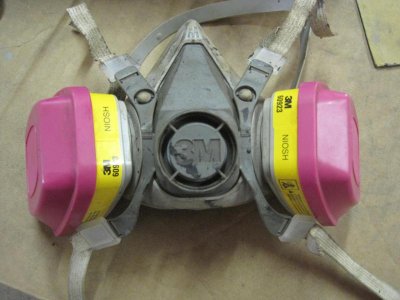I replaced the filter cartridges on my 3M respirator today and was wondering (hoping) that other members are using a respirator too and not some cheap paper mask held on by a rubber band. I searched this forum for related threads and didn't come across any, maybe because I'm being Capt. Obvious here. I realize most everyone is wearing one when painting with a spray gun but a good respirator is also vital when working in the garage grinding, sanding, spray bombing, doing anything that releases vapors or dust. Wearing a respirator with the charcoal filters, you can't even smell the fumes from whatever it is you're spraying. I've been spraying Rust-Mort, rubberized undercoating, etch primer, etc. during my Coronet's resto and I wear that thing all the time. I don't realize how potent the fumes are until I take the respirator off.
Here's a test to see if you're filtering out all the crud in the air: after you're done spending a day grinding, painting, etc. and you come into the house to take a shower, grab a Q-tip and swab inside each nostril. If the Q-tip comes back grey or worse, black, that's getting into your lungs. No exaggeration, using my 3M all day I have no residue.
Sorry if I'm sounding like Mr. Mom here, just looking out for my fellow FBBO'ers. You don't realize how much your health means until a doctor tells you that you don't have it any more, trust me I know.
Below is a pic of the 3M respirator, you can get 'em at Lowes or Home Depot for about $30; replacement cartridges are about $18. Happy and Safe wrenching.

Here's a test to see if you're filtering out all the crud in the air: after you're done spending a day grinding, painting, etc. and you come into the house to take a shower, grab a Q-tip and swab inside each nostril. If the Q-tip comes back grey or worse, black, that's getting into your lungs. No exaggeration, using my 3M all day I have no residue.
Sorry if I'm sounding like Mr. Mom here, just looking out for my fellow FBBO'ers. You don't realize how much your health means until a doctor tells you that you don't have it any more, trust me I know.
Below is a pic of the 3M respirator, you can get 'em at Lowes or Home Depot for about $30; replacement cartridges are about $18. Happy and Safe wrenching.

















